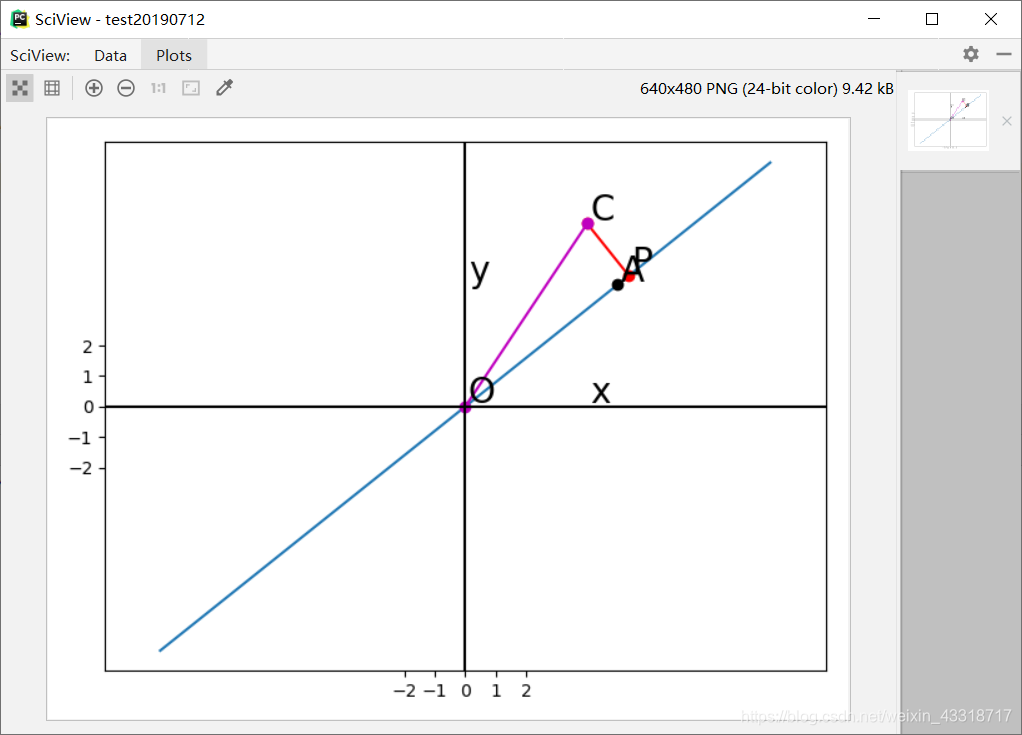实现最小二乘法
程序9-1:
import numpy as np
from matplotlib import pyplot as plt
A = np.array([[5],[4]])
C = np.array([[4],[6]])
B = A.T.dot(C)
AA = np.linalg.inv(A.T.dot(A))
l=AA.dot(B)
P=A.dot(l)
x=np.linspace(-2,2,10)
x.shape=(1,10)
xx=A.dot(x)
fig = plt.figure()
ax= fig.add_subplot(111)
ax.plot(xx[0,:],xx[1,:])
ax.plot(A[0],A[1],'ko')
ax.plot([C[0],P[0]],[C[1],P[1]],'r-o')
ax.plot([0,C[0]],[0,C[1]],'m-o')
ax.axvline(x=0,color='black')
ax.axhline(y=0,color='black')
margin=0.1
ax.text(A[0]+margin, A[1]+margin, r"A",fontsize=20)
ax.text(C[0]+margin, C[1]+margin, r"C",fontsize=20)
ax.text(P[0]+margin, P[1]+margin, r"P",fontsize=20)
ax.text(0+margin,0+margin,r"O",fontsize=20)
ax.text(0+margin,4+margin, r"y",fontsize=20)
ax.text(4+margin,0+margin, r"x",fontsize=20)
plt.xticks(np.arange(-2,3))
plt.yticks(np.arange(-2,3))
ax.axis('equal')
plt.show()
结果:

随机梯度下降算法实现
程序9-2:
x = [(2, 0, 3), (1, 0, 3), (1, 1, 3), (1,4, 2), (1, 2, 4)]
y = [5, 6, 8, 10, 11]
epsilon = 0.002
alpha = 0.02
diff = [0, 0]
max_itor = 1000
error0 = 0
error1 = 0
cnt = 0
m = len(x)
theta0 = 0
theta1 = 0
theta2 = 0
while True:
cnt += 1
for i in range(m):
diff[0] = (theta0 * x[i][0] + theta1 * x[i][1] + theta2 * x[i][2]) - y[i]
theta0 -= alpha * diff[0] * x[i][0]
theta1 -= alpha * diff[0] * x[i][1]
theta2 -= alpha * diff[0] * x[i][2]
error1 = 0
for lp in range(len(x)):
error1 += (y[lp] - (theta0 + theta1 * x[lp][1] + theta2 * x[lp][2])) ** 2 / 2
if abs(error1 - error0) < epsilon:
break
else:
error0 = error1
print('theta0 : %f, theta1 : %f, theta2 : %f, error1 : %f' % (theta0, theta1, theta2, error1))
print('Done: theta0 : %f, theta1 : %f, theta2 : %f' % (theta0, theta1, theta2))
print('迭代次数: %d' % cnt)
结果:
theta0 : 0.100684, theta1 : 1.564907, theta2 : 1.920652, error1 : 0.569459
Done: theta0 : 0.100684, theta1 : 1.564907, theta2 : 1.920652
迭代次数: 24
Python实现反馈神经网络
程序9-3:
import numpy as np
import math
import random
def rand(a, b):#生成随机数
return (b - a) * random.random() + a
def make_matrix(m,n,fill=0.0):#生成相对应的矩阵
mat = []
for i in range(m):
mat.append([fill] * n)
return mat
def sigmoid(x):#激活函数
return 1.0 / (1.0 + math.exp(-x))
def sigmod_derivate(x):#激活函数的倒函数
return x * (1 - x)
class BPNeuralNetwork:#定义BP神经网络类
def __init__(self):
#各层中节点的个数
self.input_n = 0
self.hidden_n = 0
self.output_n = 0
#各层中节点的数值
self.input_cells = []
self.hidden_cells = []
self.output_cells = []
#各层的权重
self.input_weights = []
self.output_weights = []
def setup(self,ni,nh,no):#数据初始化
self.input_n = ni + 1
self.hidden_n = nh
self.output_n = no
self.input_cells = [1.0] * self.input_n
self.hidden_cells = [1.0] * self.hidden_n
self.output_cells = [1.0] * self.output_n
self.input_weights = make_matrix(self.input_n,self.hidden_n)
self.output_weights = make_matrix(self.hidden_n,self.output_n)
# random activate
for i in range(self.input_n):
for h in range(self.hidden_n):
self.input_weights[i][h] = rand(-0.2, 0.2)
for h in range(self.hidden_n):
for o in range(self.output_n):
self.output_weights[h][o] = rand(-2.0, 2.0)
def predict(self,inputs):#前向的计算
for i in range(self.input_n - 1):
self.input_cells[i] = inputs[i]
for j in range(self.hidden_n):
total = 0.0
for i in range(self.input_n):
total += self.input_cells[i] * self.input_weights[i][j]
self.hidden_cells[j] = sigmoid(total)
for k in range(self.output_n):
total = 0.0
for j in range(self.hidden_n):
total += self.hidden_cells[j] * self.output_weights[j][k]
self.output_cells[k] = sigmoid(total)
return self.output_cells[:]
def back_propagate(self,case,label,learn):
self.predict(case)
#计算输出层的误差
output_deltas = [0.0] * self.output_n
for k in range(self.output_n):
error = label[k] - self.output_cells[k]
output_deltas[k] = sigmod_derivate(self.output_cells[k]) * error
#计算隐藏层的误差
hidden_deltas = [0.0] * self.hidden_n
for j in range(self.hidden_n):
error = 0.0
for k in range(self.output_n):
error += output_deltas[k] * self.output_weights[j][k]
hidden_deltas[j] = sigmod_derivate(self.hidden_cells[j]) * error
#更新输出层权重
for j in range(self.hidden_n):
for k in range(self.output_n):
self.output_weights[j][k] += learn * output_deltas[k] * self.hidden_cells[j]
#更新隐藏层权重
for i in range(self.input_n):
for j in range(self.hidden_n):
self.input_weights[i][j] += learn * hidden_deltas[j] * self.input_cells[i]
error = 0
for o in range(len(label)):
error += 0.5 * (label[o] - self.output_cells[o]) ** 2
return error
def train(self,cases,labels,limit = 100,learn = 0.05):#训练函数
for i in range(limit):
error = 0
for i in range(len(cases)):
label = labels[i]
case = cases[i]
error += self.back_propagate(case, label, learn)
pass
def test(self):#测试函数
cases = [
[0, 0],
[0, 1],
[1, 0],
[1, 1],
]
labels = [[0], [1], [1], [0]]
self.setup(2, 5, 1)
self.train(cases, labels, 10000, 0.05)
for case in cases:
print(self.predict(case))
if __name__ == '__main__':
nn = BPNeuralNetwork()
nn.test()
结果:
[0.10161506275617728]
[0.8956560067670083]
[0.8829086849780357]
[0.10864929306973252]








 本文通过Python实现最小二乘法解决线性回归问题,并使用随机梯度下降算法进行参数优化。此外,还展示了如何构建反馈神经网络并对其进行训练。
本文通过Python实现最小二乘法解决线性回归问题,并使用随机梯度下降算法进行参数优化。此外,还展示了如何构建反馈神经网络并对其进行训练。
















 978
978

 被折叠的 条评论
为什么被折叠?
被折叠的 条评论
为什么被折叠?








